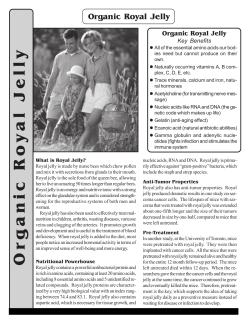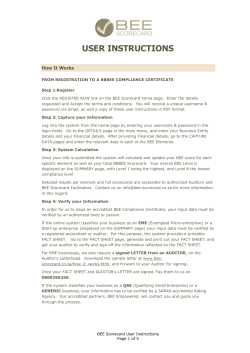
Bee Pollen, Propolis & Royal Jelly
Bee Pollen, Propolis & Royal Jelly ©2005 Huntington College of Health Sciences Literature Education Series On Dietary Supplements By Gene Bruno, MS, MHS – Dean of Academics, Huntington College of Health Sciences Smart Supplementation™ is a free series of educational literature created by Huntington College of Health Sciences (HCHS) as a public service. Although copyrighted, it may be freely photocopied and distributed, but may not be altered in any way. Smart Supplementation™ is not intended as medical advice. For diagnosis and treatment of any medical condition, consult your physician. The common honey bee is a fascinating little insect that offers us humans some valuable natural foods with health-promoting benefits. These “super foods” include bee pollen, royal jelly and propolis. Bee Pollen Bee pollen is the pollen gathered from plants by honey bees, and brought back to their hive. Bee pollen contains all of the eight essential amino acids in amounts that vary between five to seven times the level found in equal weights of traditional high protein foods. It also contains vitamins A, D, E, K, C and bioflavonoids, as well as the complete Bcomplex; especially pantothenic acid (B5) and niacin. The high levels of vitamin B5 are particularly beneficial for the adrenal glands which are adversely affected during stress. Bee pollen has been used traditionally as an anti-aging food, and an energy food. As a matter of fact, it has been used by a number of Olympic athletes to improve their performance. Antioxidant/anti-aging The oxidative damage caused be free radicals have been implicated in quite a number of disease processes, and is the primary factor in aging. Antioxidants are capable of providing protection, sometimes significant protection, against this oxidative damage. Interestingly, bee pollen appears to provide significant antioxidant activity, which may explain its traditional use as an anti-aging food. One animal study demonstrated that bee pollen (as well as beta-carotene oil), was able to abolish the effects of harmful ionizing radiation on the brain. This was a function of bee pollen’s antioxidant properties.1 Xrays can activate lipid peroxidation (i.e., free radical activity) in the liver, and adversely affect liver glutathione (i.e., antioxidant) systems. Animal research has shown that bee pollen is able to normalize the activity of important glutathione system enzymes in the liver.2 Another study demonstrated that bee pollen was able to markedly decrease lipoperoxide levels in animals fed a limited diet, compared to animals not receiving bee pollen.3 Free radicals can also contribute towards lipofuscin, also known as age pigments and liver spots. These are commonly seen as small brownish spots on the back of hands on elderly people. Liver spots are actually an outward sign of internal toxic accumulation of lipofuscin; including, but not limited to vital nerve centers such as the brain. Such toxic accumulation of lipofuscin can block nutrient absorption in the cells. Animal research has shown that bee pollen markedly reduces lipofuscin in the cardiac muscle (heart), significantly inhibits the increase of lipofuscin in cardiac muscle, liver, brain and adrenal gland cells.4 Increase red blood cells & hemoglobin Traditionally, bee pollen has been used as a food to help increase energy levels. One possible explanation for this use is that bee pollen helps to increase red blood cells, and the hemoglobin component of red blood cells. Since it is the hemoglobin in red blood cells that carry oxygen for energy metabolism, this may explain the relationship between bee pollen and energy. For example, in one animal study, bee pollen resulted in increases in hemoglobin and serum iron.5 In a study on humans, bee pollen and several other Chinese herbs were found to increase the number of red blood cells.6 Bee Propolis Propolis is a resinous substance collected from various plants by bees. It is used in the construction of, and to seal the cracks in, the bee hive. For this reason, propolis is often referred to as “bee glue.” It is a mixture of resin, essential oils and waxes, and also contains amino acids, minerals, ethanol, vitamin A, B complex, E, and flavonoids.7 In addition to its construction adhesive application, propolis also has antimicrobial properties, which helps to prevents 1 Huntington College of Health Sciences • 800-290-4226 • www.hchs.edu microorganisms from entering the hive and causing illness. Antibacterial/antifungal activity In-vitro (i.e., “test tube”) research has demonstrated that propolis has significant antibacterial activity, and also helps to reduce oxidation potential.8 Other research has also verified that the growth of bacteria (particularly Gram-positive bacteria) is inhibited by propolis.9 10 11 In addition to its antibacterial properties, propolis has also been found to have antifungal effects against Candida albicans.12 Furthermore, research has shown that propolis has specific antibacterial activity against several strains isolated from patients with infections in their upper respiratory tracts.13 Dental research Some interesting dental studies have also been conducted on the value of propolis, including its antibacterial properties. In one study, propolis was found to inhibit certain enzymes and bacteria that are chief culprits in the formation of dental caries (cavities).14 Other research on propolis has also demonstrated a similar antibacterial effect, including a reduction of bacteria in saliva.15 Another dental-related value of propolis is its desensitizing properties for teeth. In one study, propolis was administered to 26 women over a period of four weeks. The women were tested for teeth sensitivity by two methods: 1) cold air stimuli, and 2) subjective reporting of pain. Eighty five percent of the subjects in this study reported that they were highly satisfied; the propolis had significant desensitizing effects on their sensitive teeth.16 Anti-viral activity Besides its antibacterial properties, propolis has also demonstrated significant antiviral propertiesCparticularly where cold viruses are concerned. For example, in one study, preschool and school children were treated with propolis during the cold season. Favorable effects of propolis treatment were observed, including a lowering of the number of cases common cold with acute or chronic symptoms, and decrease and suppression of the viruses and other microbes in the upper airways.17 Other research demonstrated that propolis was effective in shortening the duration of a cold. Specifically, regression of symptoms occurred in the first day of propolis therapy, and the complete recovery followed in 1 day in 5 patients, in 2 day in16, and in 3 day in 3. The placebo group had full recovery in 4.80 days. In the propolis-treated group the symptoms lasted 2.5 time shorter than in placebo one.18 Propolis also has promising antiviral properties against herpes viruses.19 In-vitro research has shown that propolis has activity against herpes simplex virus type 1, reducing viral activity and replication.20 Other in-vitro research has also shown that the flavonoids found in propolis caused a reduction of intracellular replication of herpes-virus strains.21 Finally, in one in-vitro study propolis was found to suppress the replication of HIV-1 virus, as well as modulate immune responses.22 Two to four tablets of propolis daily are typically used. Royal Jelly Royal jelly is a substance produced by worker honey bees. If fed to an ordinary female bee in the larval stage, royal jelly will transform her into the queen bee. As a queen, she will grow 1½ times normal size, become extremely fertile and lay over a thousand eggs each day. Incredibly, she may live over five years while all the other bees live only a few weeks. The only difference is that she receives royal jelly while the others don’t. The chemistry of royal jelly Royal jelly is a complex mixture of proteins (12%), sugar (12%), fats (6%) and variable amounts of minerals vitamins and pheromones. About 15% of royal jelly is 10-hydroxy-trans-(2)-decanoic acid (HDA), which is probably the substance that causes the queen bee to grow so large. Royal jelly is particularly rich in B vitamins, with pantothenic acid dominating. Royal jelly folk use Royal jelly has a history of folk use as a skin tonic and hair growth stimulant. The skin benefits are supposed to include a nourishing process that reduces wrinkles, although there is no actual scientific research that supports these claims (or the hair growth claims). Royal jelly has also been considered to be a general tonic that has a general systemic action rather than any specific biological function, which benefits menopause and sexual performance. Perhaps it’s most significant use has been as an aid for increasing energy. Royal jelly research Scientific research on royal jelly has revealed that it possesses antitumor activity in experimental mouse leukemias.23 Additional research has demonstrated that royal jelly has antibacterial activity against Gram-positive bacteria, but not against Gram-negative bacteria.24 Furthermore, research with chronically diabetic rats demonstrated that royal jelly possesses an anti-inflammatory action and is able to augment wound healing.25 Royal jelly has also been shown to prevent the cholesterol-elevating effect of nicotine26, and has lowered serum cholesterol in animal studies.27 Some research has also demonstrated that royal jelly can lower 2 Huntington College of Health Sciences • 800-290-4226 • www.hchs.edu cholesterol levels in humans.28 29 Cholesterol-lowering research has shown that the typical dose used for this purpose is 50-100 mg daily.30 29 Liusov VA, Zimin IU, Kardiologia (1983) 23:1059 [in Russian]. 30 Vittek J, Experientia (1995) 51:927-35. References 1 Anan'eva TV, Dvoretskii AI, Radiatsionnaia biologiia, radioecologiia (1999) 39(2-3):341-4 2 Bevzo VV, Grygor'eva NP, Ukrainskii biokhimicheskii zhurnal (1997) 69(4):115-7. 3 Qian B; Zang X; Liu X, Chung-kuo chung yao tsa chih (1990) 15(5):301-3, 319. 4 Liu X, Li L, Chung-kuo chung yao tsa chih (1990) 15(9):561-3, 578. 5 Xie Y, Wan B, Li W, Hua hsi i k'o ta hsueh hsueh pao (1994) 25(4):434-7. 6 Iversen T, et al, Journal of ethnopharmacology (1997) 56(2):109-16. 7 Mahmoud AS, Almas K, Dahlan AA, Indian journal of dental research (1999) 10(4):130-7. 8 Drago L, et al, Journal of chemotherapy (2000) 12(5):390-5. 9 Kobayashi N, et al, In vivo (2001) 15(1):17-23. 10 Marcucci MC, et al, Journal of ethnopharmacology (2001) 74(2):105-12. 11 Grange JM, Davey RW, Journal of the Royal Society of Medicine (1990) 83(3):159-60. 12 Koo H, et al, Archives of oral biology (2000) 45(2):141-8. 13 Focht J, et al, Arzneimittel-Forschung (1993) 43(8):921-3. 14 Park YK, et al, Current microbiology (1998) 36(1):24-8. 15 Steinberg D, Kaine G, Gedalia I, American journal of dentistry (1996) 9(6):236-9. 16 Mahmoud AS, Almas K, Dahlan AA, Indian journal of dental research (1999) 10(4):130-7. 17 Crisan I, et al, Romanian journal of virology (1995) 46(3-4):115-33. 18 Szmeja Z, et al, The Polish otolaryngology (1989) 43(3):180-4. 19 Esanu V, Virologie (1981) 32(1):57-77. 20 Amoros M, et al, Journal of natural products (1994) 57(5):644-7. 21 Debiaggi M, et al, Microbiologica (1990) 13(3):207-13. 22 Harish Z, et al, Drugs under experimental and clinical research (1997) 23(2):89-96 23 Tamura T, Fujii A, Kuboyama N, Nippon Yakurigaku Zasshi (1987) 89(2):73-80. 24 Fujiwara S, et al, J Biol Chem (1990) 265(19):11333-7. 25 Fujii A, et al, Jpn J Pharmacol (1990) 53(3):331-7. 26 Abou-Hozaifa BM, Badr El-Din NK, Saudi Med J (1995) 16:337-42. 27 Abou-Hozaifa BM, Roston AAH, El-Nokaly FA, J Biomed Sci Ther (1993) 9:35B44. 28 Cho YT, Am Bee J (1977) 117:36-39. For more than two decades, Huntington College of Health Sciences (HCHS) has offered more than a conventional undergraduate or graduate education. Our accredited*, distance learning degrees and diploma programs also include the breadth of responsible complementary and alternative medicine viewpoints, providing our students with a well-rounded and comprehensive approach to nutrition and the health sciences: • • • • • • • • • Master of Science in Nutrition Bachelor of Health Science in Nutrition Associate of Science in Applied Nutrition Diploma in Comprehensive Nutrition Diploma in Dietary Supplement Science Diploma in Sports Nutrition Diploma in Women’s Nutrition Diploma in Natural Sciences Diploma in Small Business Management 1204D Kenesaw Knoxville, TN 37919 865-524-8079 • 800-290-4226 E-Mail: studentservices@hchs.edu www.hchs.edu.com *Accredited member Distance Education & Training Council. 3 Huntington College of Health Sciences • 800-290-4226 • www.hchs.edu
© Copyright 2025



















